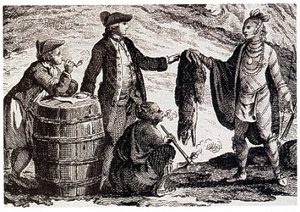The Fur Trade in North America
The fur trade thrived for more than 200 years in North America, operated by European and Native American trappers and traders and fueled by a demand for animal skins used to make items of clothing that Europeans couldn't get elsewhere. Europeans began coming to North America in increasing numbers in the 16th Century. The first permanent settlements for each major Western Europe power were these:
The two largest European competitors in the fur trade were England and France. (Conflicts between England and both Sweden and the Netherlands resulted in the reduction of trading operations by the latter two nations; eventually England took over all lands owned by those two countries.) One of the earliest French explorers to conduct fur trading with Native Americans was Jacques Cartier, who as early the 1530s was roaming the area around the St. Lawrence River and the Gulf of St. Lawrence.  A regular fur trade between New France (Canada) and Europe was established in the 1630s. French settlers began in Quebec in 1608 and then expanded operations along the St. Lawrence River and in the Great Lakes area. A main driver in the founding of Quebec was Samuel de Champlain, who drove the expansion of the trade in the next several years. The French also built a trading post at Chequamagon Bay on Lake Superior in 1659, as more and more Native American tribes were living in the area. Relations with French traders and Native Americans was not always peaceful. Conflict was regular, and armed conflict was not uncommon. Competition in the fur trade extended to different Native American tribes as well, and the 17th-Century Beaver Wars were a conflict both among those tribes (fighting amongst themselves) and between France and those tribes for prominency in fur trading with Europeans. 
In 1670 came one of the most famous fur trading companies in the history of North America, the Hudson's Bay Company. The founders of that company claimed as their trading jurisdiction all the lands that drained into Hudson Bay, where they had a trading post. Native Americans would trade fur from beavers, deer, foxes, minks, otters, raccoons, and other animals to Europeans, who would, in return, hand over tools and weapons. Some tribes, such as the Huron and the Ottawa, served as traders. Europeans would sell the furs or make from them blankets, coats, and hats; demand for all was high in Europe and in the North American European colonies. The beaver hat, in particular, was in high demand for many years in Europe. A consequent economic benefit in a related field was the rise in demand for tanning of the skins and hides brought back from points west. Next page: France and Great Britain > Page 1, 2, 3, 4 |
|
Social Studies for Kids
copyright 2002–2025
David White




